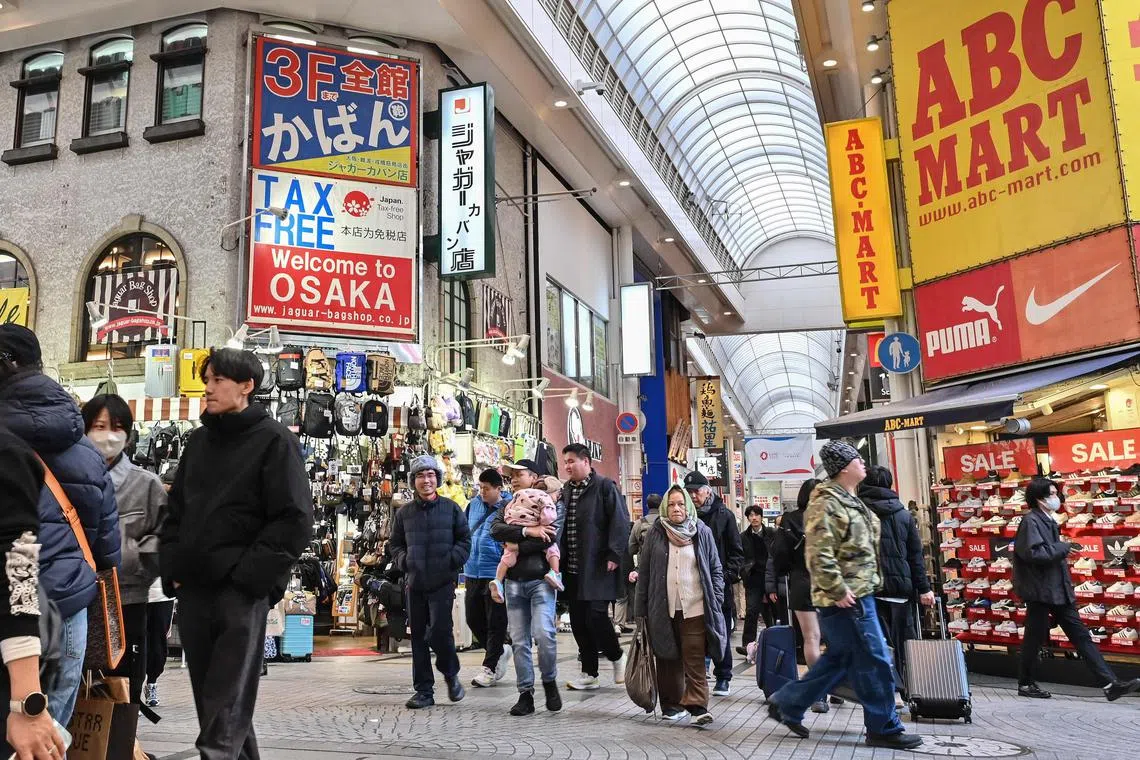Luxury, hotel stocks all the rage as tourists flock to Japan
Sign up now: Get ST's newsletters delivered to your inbox

Japan is set to welcome 40.2 million tourists in 2025, driven by the weak yen and the World Expo 2025 in Osaka, travel agency JTB Corp predicts.
PHOTO: AFP
Follow topic:
TOKYO – Japan’s stock market is only now waking up to potential gains from record numbers of big-spending tourists.
A growing number of companies, including a seller of vintage goods and a budget hotel chain, are poised for a strong 2025 as increased demand from foreigners boosts earnings outlooks.
Japan welcomed almost 37 million inbound visitors in 2024, data released last week by the Japan National Tourism Organisation showed. That is almost a third of the country’s population.
Those numbers are set to increase to 40.2 million in 2025, driven by the weak yen and the World Expo 2025 in Osaka, travel agency JTB Corp predicts. As equity markets prepare for an uncertain year under the Trump presidency in the US, Japan’s tourism-related stocks appear to be a pretty safe bet.
Analysts see the benefits of increased tourism, already felt by department stores, spreading to more domestic stocks in 2025.
Hotel operators such as Kyoritsu Maintenance – owner of the budget Dormy Inn chain – Fujita Kanko and TKP Corp may be major winners, especially if they hike prices to capitalise on higher demand, said Mr Hiroyuki Terada, senior analyst at UK firm Pelham Smithers Associates.
“Kyoritsu should see growth. Demand is strong, higher prices are supporting profits, and they’re planning to open new hotels,” Mr Terada said. The company runs more than 90 hotels throughout Japan. Maintenance costs, which have pressured earnings since the pandemic, should fall in 2025, he added.
Souvenir retailers such as Kotobuki Spirits are also set for a boost. Mr Norihiro Miyazaki and other Goldman Sachs analysts added the sweets maker to their top buy-rated Japan picks in January, on expectations that more footfall at airport gift shops will drive earnings growth.
Major carrier ANA Holdings is expanding international flights in 2025 to “capture inbound demand”, according to an announcement on Jan 21.
A jump in duty-free sales helped fuel an 18 per cent year-on-year rise in profit in the last quarter for department store operator J Front Retailing, driving optimism in other luxury consumer stocks.
Second-hand goods chain Treasure Factory received 10 per cent of its sales revenue from inbound tourists in the March to November period, largely from higher-priced designer items.
Tourists spent 8.1 trillion yen (S$70.4 billion) in Japan in 2024, the most on record, according to government statistics. The average spending per person was 43 per cent more than in pre-pandemic 2019. The Chinese were the biggest spenders, accounting for 21 per cent of total consumption, the data showed.
As Japan’s government plans to ease entry restrictions for visitors from China, vintage sellers such as Treasure Factory stand to gain from a likely increase in big-spending Chinese tourists, Mr Terada said.
Granted, tourism-reliant stocks are vulnerable to a potential strengthening in the yen, which is likely if the Bank of Japan (BOJ) raises rates further. The swaps market is increasingly pricing in such a move this week.
That said, the currency is unlikely to strengthen to a point that would pose a “significant threat” to inbound-related stocks, said Ms Hui Shi Yeo, assistant manager of research and portfolio management at Singapore-based fintech firm iFast. “Given a cautious BOJ, the pace of any yen gains is likely to be gradual,” she said.
The World Expo in Osaka, scheduled for April to October, should boost tourism irrespective of the yen, Mr Terada said. The event is expected to draw around 3.5 million overseas visitors and should generate almost 200 billion yen in foreign tourist spending, according to the Asia-Pacific Institute of Research. BLOOMBERG

